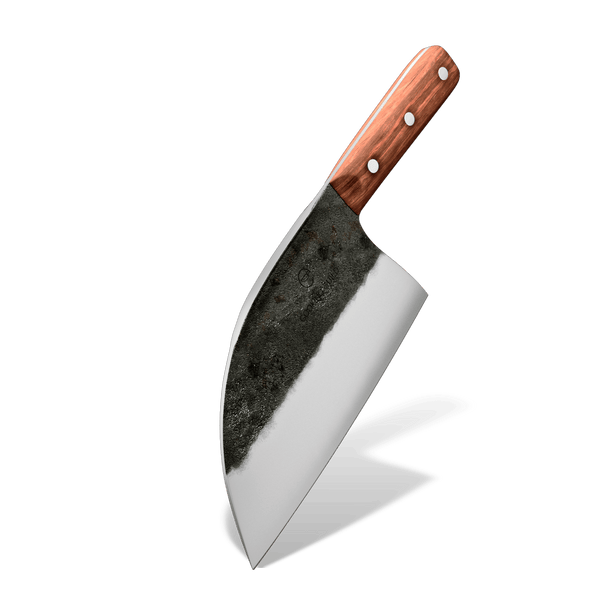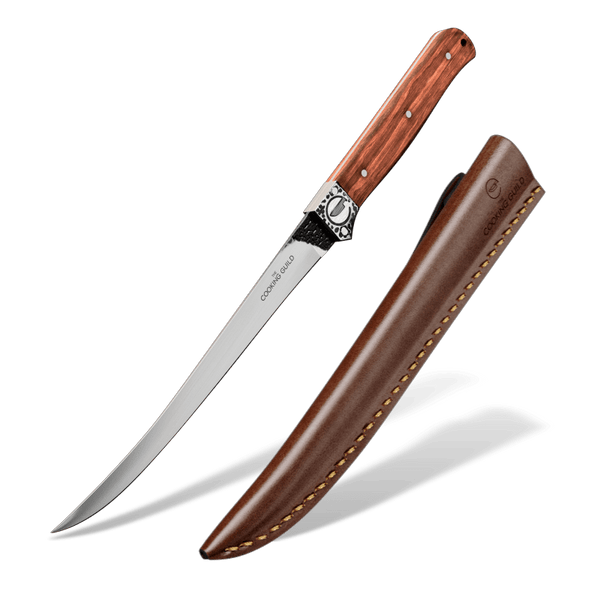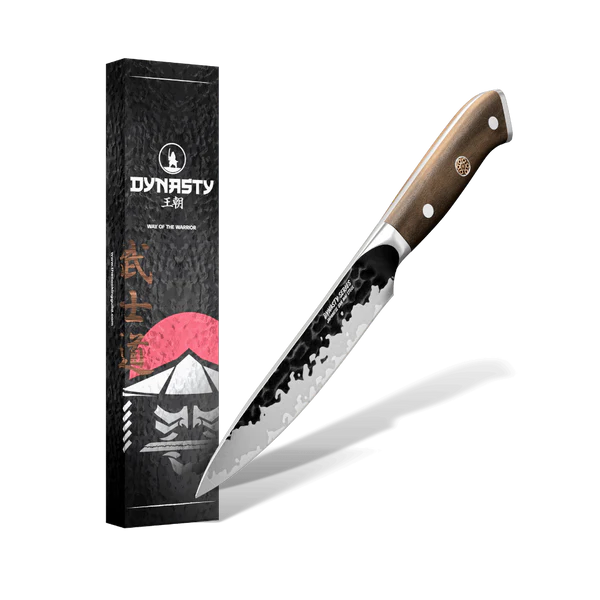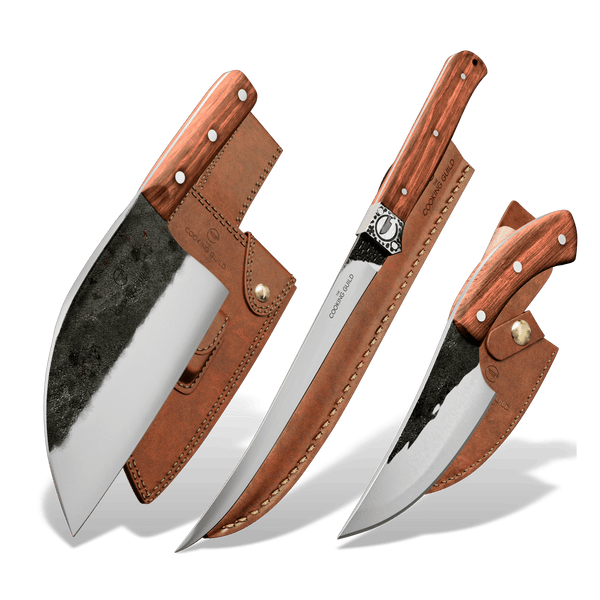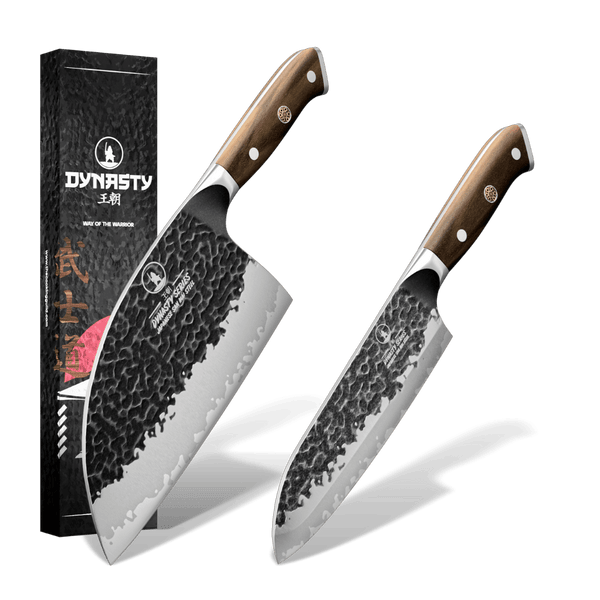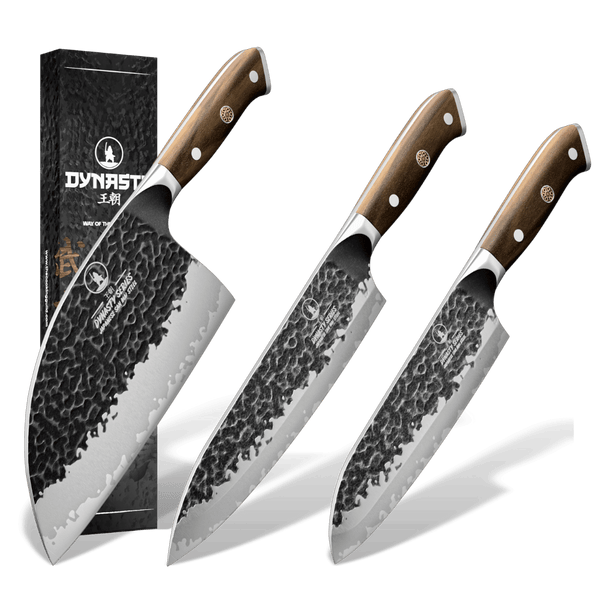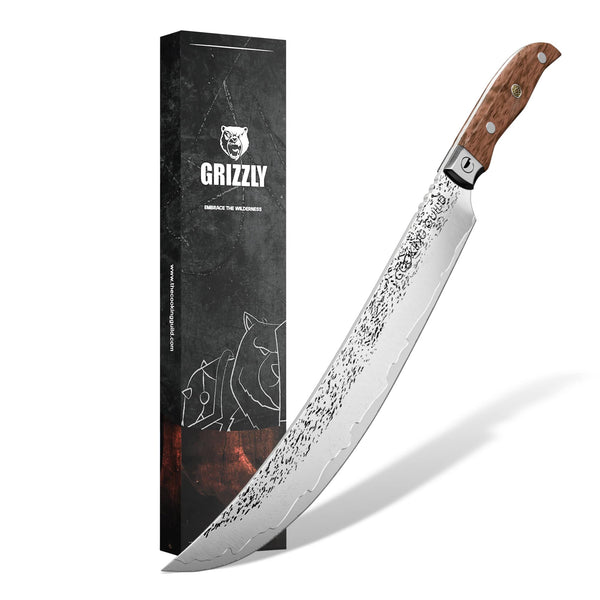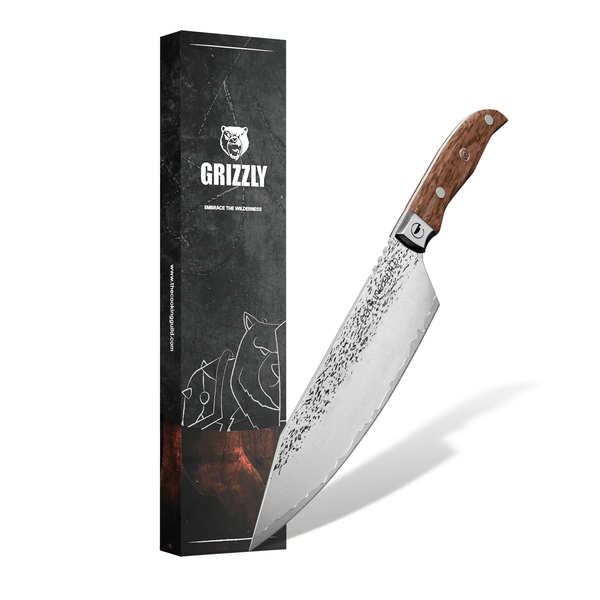Let's dive into the fascinating world of Chinese cleavers, where tradition and practicality come together to create a kitchen tool that's both versatile and cherished. These culinary companions, often referred to as "chef's knives," boast a rich history and a unique design that sets them apart from their Western counterparts. Whether you're a professional chef or an enthusiastic home cook, the Chinese cleaver's friendly shape and functionality are sure to make your cooking experience even more enjoyable and efficient. So, let's explore the story behind these remarkable knives and discover how they've become an essential part of kitchens around the globe!
Are You Familiar With Chinese Cleavers?
If you're just beginning to navigate the realm of kitchen knives, you're in for a treat with the remarkable Chinese cleaver. Among the array of knife types, the Chinese cleaver reigns as the pinnacle of versatility. But wait, there's more than meets the eye when it comes to this tool's variety. The Chinese cleaver that most readily comes to mind boasts a distinct rectangular form, featuring a keen blade and edge set at a precise 16-degree angle. In a nod to its hatchet-like appearance, it's often linked with tasks involving meats and bones. Yet, its expansive flat surface proves equally adept at gracefully pulverizing ingredients during culinary endeavors.
The influence of the Chinese cleaver extends beyond its place of origin with versions found in Japan. In Japan, the Japanese version is called the "Chukabocho," revealing its cross-cultural impact and enduring popularity. The Nakiri knife, a modified version of the Chinese cleaver, finds its specialty in vegetable prep while boasting versatility across the kitchen. Conversely, the Santoku knife is a reimagined Western chef's knife tailored to Japanese culinary techniques.
What Is A Chinese Cleaver, And What's It Used For?
The Chinese cleaver, with its distinct design, showcases a broad, rectangular blade united with a wooden handle. It diverges markedly from its Western chef's knife counterpart in several key aspects. Notably, its blade lacks the pointed tip synonymous with Western knives, instead favoring a squared-off edge that boasts generous surface coverage. Unlike the even weight distribution of Western or Japanese knives, the Chinese cleaver concentrates its heft within the blade, resulting in a pronounced front-weighted balance. This configuration can be initially imposing—recalling an incident where our cleaver inadvertently met the kitchen floor, it was the tile that splintered, not the blade. Yet, with practice comes insight: gravity evolves into an ally, its force and momentum yielding precision cuts with reduced exertion.
In the realm of Chinese knives, two archetypes prevail. The first is the meat cleaver, known as "gudao" or "bone knife" in Mandarin. These exhibit considerable heft, sporting thicker blades tailored for navigating tough bones. The second category encompasses the Chinese vegetable cleaver, often titled "caidao" or Chinese chef's knife.

The Basics Of Chinese Knives
From the iconic cleaver's versatility to specialized blades rooted in tradition, Chinese knives encompass both art and function, offering a glimpse into the heart of Chinese cuisine and culture and we’ll cover all of the basics from shapes and sizes, to weights and uses.
A Quick Primer On Chinese Knives
Chinese knives, steeped in a rich culinary heritage, showcase a remarkable blend of form and function. The spotlight shines on two iconic blades: the Chinese cleaver and the Chinese chef knife. The versatile Chinese cleaver, with its distinctive rectangular shape and precise edge, effortlessly handles a wide range of tasks, from delicate slicing to efficient chopping. On the other hand, the Chinese chef knife, with its curved blade and sharp point, brings finesse to intricate techniques and precise cuts. Both knives are a testament to Chinese culinary expertise, bridging tradition and innovation in the kitchen.
The Versatility Of A Chinese Chef Knife
While occasionally referred to as a Chinese cleaver, this knife notably distinguishes itself by its thinner profile compared to cleavers intended for bone or dense meat hacking. The Chinese chef knife boasts impressive versatility, akin to a Swiss army knife albeit without its numerous attachments.
- The curved blade and sharp point allow for precise slicing and dicing of a variety of ingredients, from vegetables to fruits, with consistent and clean cuts.
- The gently curved edge facilitates a smooth rocking motion, making it perfect for mincing herbs, garlic, and shallots, resulting in finely chopped ingredients.
- The pointed tip and maneuverability of the blade make it adept at boning and filleting meats, poultry, and fish, enabling precise removal of bones and skin.
- The wide blade length and surface efficiently scoop and transfer chopped ingredients from the cutting board to the cooking pot or pan, streamlining the cooking process.
- The versatility of the knife extends to chopping tasks, effortlessly handling everything from herbs to boneless cuts of meat.
The Power Of A Chinese Cleaver
The Chinese cleaver possesses a power unique to its culinary domain. This kitchen marvel stands out for its distinctive design, setting it apart from its bone-crushing counterpart. Unlike traditional cleavers designed for blunt force, the Chinese cleaver boasts a different kind of might. Its power emanates from its impressive thickness and heft, making it a heavyweight champion in the culinary world.
The Chinese cleaver's power lies not in its delicacy but in its substantial build. It defies the stereotype of lightweight knives, wielding a thicker and heavier blade that speaks to its prowess in tackling demanding tasks. This thickness and weight enable it to handle even the toughest of ingredients, from dense root vegetables to sizeable cuts of meat.
Its robustness allows for a range of applications, from adeptly chopping through bone-in cuts to skillfully dicing and slicing with controlled precision. Its substantial blade surface provides efficient ingredient transfer and effective crushing when needed.
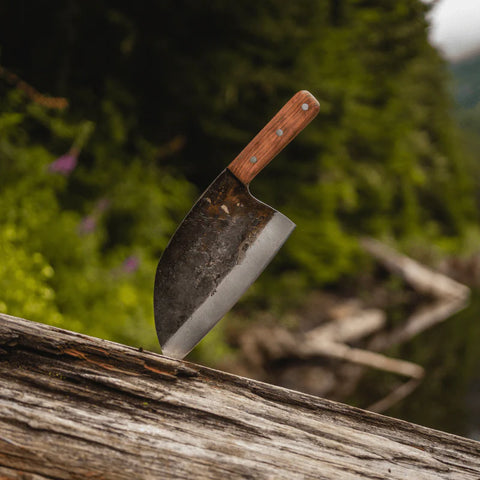
How To Sharpen A Chinese Chef Knife
A well-sharpened knife isn't just a kitchen tool; it's a culinary ally that ensures precision and efficiency in your cooking endeavors. For those who wield a Chinese chef knife, mastering the art of sharpening is key to maintaining its versatility and finesse. In this guide, we'll delve into the intricacies of sharpening a Chinese chef knife, covering everything from the tools you need to the techniques that yield a blade that's keen, precise, and ready to conquer any culinary challenge.
An Overview of the Main Sharpening Tools
When it comes to knife sharpening, the right tools are your best friends. From traditional whetstones to modern honing rods, understanding the options at your disposal is the first step towards achieving a finely honed edge.
Why Do We Sharpen Knives?
Knife sharpening goes beyond the mere act of maintaining a blade's edge; it's an essential step in achieving culinary excellence. A sharp knife embodies precision, turning routine tasks into graceful movements that honor ingredients and elevate dishes. Beyond safety, a sharp knife enhances the presentation, ensuring uniform cuts that speak to aesthetics on the plate. It's a tradition that connects us to the craft of cooking and the generations that came before us, infusing our culinary endeavors with heritage. Sharpening knives isn't just a routine; it's a commitment to unlocking our culinary potential and crafting meals that are a testament to skill, tradition, and respect.
What Makes a Knife Dull?
Ever wondered why your once-sharp Chinese chef knife seems to lose its edge? Frequent use on abrasive surfaces, such as cutting boards made of hard materials, can accelerate wear and tear on the blade, leading to loss of sharpness. Additionally, the minerals present in various foods can contribute to the blunting process. As you slice through ingredients like hard root vegetables or meat with bones, the blade might encounter microchips or dents that gradually degrade its keen edge. Over time, even the finest blade will show signs of wear, reminding us that the art of maintaining sharpness is as vital as the act of cutting itself.
Honing vs. Sharpening Your Knife
Honing and sharpening are distinct techniques in knife care. Honing involves realigning the blade's edge, enhancing its current sharpness. It's a maintenance ritual to be performed frequently. Sharpening, on the other hand, removes material to restore a dulled edge to peak sharpness. It's a less frequent, more intensive process that rejuvenates the knife's cutting ability. While honing keeps your knife in top shape between sharpening sessions, sharpening brings back its true cutting prowess.
One-sided Bevel: Navigating the Unique Edge
Chinese chef knives often feature a one-sided bevel, presenting a unique challenge in the sharpening process. Sharpening a one-sided bevel demands careful attention to maintaining the blade's asymmetry. Utilizing consistent and controlled strokes on the flat side while addressing the bevel side delicately ensures the edge remains aligned and sharp, despite its unique structure. Double-sided bevel knives, like the Nakiri, require a different sharpening technique.
How Do You Know What Angle to Sharpen Your Knife At?
Discovering the ideal sharpening angle depends on your knife's design and purpose. Typically, Chinese cleavers are sharpened at an angle of around 15-20 degrees. Adapting to your knife's unique characteristics and your preferred cutting techniques guides you towards the perfect angle.
How Often Do You Need to Sharpen a Knife?
Sharpening frequency depends on factors like usage and knife type. Generally, Chinese cleavers benefit from sharpening every few weeks to a few months, depending on how often they're employed. Regular assessment of blade performance helps determine when a sharpening session is due.
How Do You Test the Sharpness of Your Knife?
Testing a knife's sharpness involves simple methods like the paper test or the tomato test. A sharp knife effortlessly slices through paper or tomato skin with minimal resistance. If it fails to cut smoothly and instead tears or crushes, it's a clear indicator that your blade requires sharpening.
Using a Whetstone: A Classic Approach
Discover the timeless art of sharpening with a whetstone. To sharpen a knife using a whetstone, follow these steps:
- Soak the whetstone in water for around 10-15 minutes to ensure it's properly saturated.
- Place the whetstone on a stable surface with a towel or non-slip base underneath for stability.
- Hold the knife at the appropriate angle (around 15-20 degrees for a Chinese cleaver) against the whetstone. Maintain this angle throughout the process.
- Starting at the base of the blade, gently slide the blade across the whetstone towards the tip in a sweeping, diagonal motion. Apply light pressure.
- Repeat this process, alternating sides, for about 10-15 strokes on each side of the blade.
- Test the blade's sharpness with the paper or tomato test. If it cuts smoothly, you've achieved the desired sharpness.
- Finish by honing the edge on the fine side of the whetstone, using lighter pressure and fewer strokes.
- Rinse the blade to remove any residue from the sharpening process. Dry it thoroughly to prevent corrosion.
Using a Honing Rod: Modern Precision

Honing rods provide a quick and efficient way to maintain your Chinese chef knife's edge between sharpening sessions. Honing a knife with a honing rod is a simple process:
- Ensure your honing rod is clean and well-maintained. Hold it upright with the handle firmly in your non-dominant hand.
- Hold the knife's handle in your dominant hand and place the blade against the top of the honing rod, near the handle.
- Hold the knife at a 15-20 degree angle against the honing rod. The blade's edge should touch the rod.
- Keeping the blade's edge in contact with the rod, gently swipe the knife down the rod's length, pulling it towards you in a sweeping motion. Maintain light pressure.
- Alternate sides with each swipe, ensuring you hone both sides of the blade evenly. Repeat this process 5-10 times on each side.
- After honing, test the blade's sharpness using the paper or tomato test. If it cuts smoothly, your knife is honed and ready.
Using a Dinner Plate: A Resourceful Hack
In a pinch? A dinner plate can serve as a makeshift sharpening tool for your Chinese chef knife. Here's how:
- Choose an unglazed ceramic or porcelain dinner plate. Avoid plates with patterns or designs.
- Place the plate on a stable surface, ensuring it won't move during the process.
- Hold the knife at a 20-degree angle against the plate's edge. Apply gentle pressure.
- Starting from the base, slide the blade across the plate's edge, moving towards the tip. Repeat this motion several times on each side of the blade.
- Test the knife's sharpness using the paper or tomato test. If it cuts smoothly, you've successfully improved the edge.
- Finish by lightly honing the blade's edge on a finer section of the plate.
- Rinse the blade and dry it thoroughly after sharpening.
While this method isn't as precise as using specialized tools, it can provide a temporary sharpening solution when needed. Regular maintenance with proper sharpening tools remains crucial for maintaining optimal blade performance.
How To Use Your Cleaver
The Chinese cleaver, an emblem of culinary prowess, holds the potential to revolutionize your cooking experience. From bold, robust actions to delicate precision, this all-encompassing tool is designed to be your kitchen's ultimate multitasker. In this guide, we'll navigate the art of using your cleaver with finesse, exploring its various applications and empowering you to make the most of its dynamic capabilities.
To wield the cleaver skillfully, start with a solid grasp. Allow the blade's weight to balance effortlessly in your hand while ensuring your grip offers control and stability.
Using a cleaver effectively involves mastering a few key techniques:
- Grip and Balance: Hold the cleaver's handle with a firm grip, allowing the blade's weight to balance naturally in your hand.
- Chopping and Slicing: For large cuts like meat or poultry, position the blade at a slight angle and use a swift, downward chopping motion. For precise slicing, maintain a controlled rhythm as the cleaver glides through ingredients.
- Smashing and Crushing: Utilize the flat side of the blade to crush garlic, ginger, or herbs. Apply pressure evenly to achieve the desired consistency.
- Scooping and Transferring: The broad blade excels at scooping and transferring ingredients. Use the cleaver to gather chopped items from the cutting board into a pan
- Vegetable Knife: For vegetables, use the cleaver's wide surface to scoop and transfer diced pieces. Embrace the cleaver's versatility for tasks like peeling, too.
- Stir-Fry Mastery: In Asian stir-frying, employ swift, rhythmic chopping and slicing motions to prepare ingredients efficiently for wok-based dishes.
- Safety First: Always use a sturdy cutting board and pay attention to your fingers' placement to ensure safe and precise cutting.
Remember, practice makes perfect. As you familiarize yourself with the cleaver's unique attributes and master these techniques, you'll unlock its potential to become an invaluable kitchen companion for a wide range of culinary tasks.

How To Clean A Chinese Cleaver
Cleaning a Chinese chef knife requires care to preserve its sharpness and integrity. Here's a simple process to follow:
- After use, promptly rinse the knife under warm water to remove food particles and prevent staining.
- Use a mild dish soap and a soft sponge or cloth to gently clean the blade and handle. Avoid abrasive scrubbers that might scratch the surface.
- Dry the knife thoroughly with a clean towel to prevent moisture buildup, which can lead to corrosion.
- If your knife has a wooden handle, avoid prolonged exposure to water. Wipe the handle dry after washing to prevent swelling and potential damage.
- Store your knife in a knife block, magnetic strip, or blade guard to protect the edge and prevent accidents.
- For added protection, apply a thin layer of food-safe mineral oil to the blade occasionally, especially if you won't be using the knife for an extended period.
Remember, your Chinese chef knife is a valuable tool. Treating it with respect and care during cleaning ensures it remains a dependable companion in your culinary endeavors.
Make Your Cleaver Last
By embracing the steps above, you're giving your cleaver a big high-five for all the amazing culinary moments it helps create. These practices aren't just about maintaining your cleaver, they're about ensuring it stays your trusty cutlery, ready to tackle delicious dishes with you for a long time to come.
What Do You Need To Consider When Buying A Chinese Cleaver?
This versatile tool holds the potential to elevate your cooking experience to new heights. However, with various options on the market, it's essential to navigate the landscape with insight. Let's delve into key considerations that will guide you toward a Chinese cleaver that harmonizes seamlessly with your cooking style and preferences.
Size and Weight
Think about how the cleaver feels in your hand. Do you want something smaller for detailed work or a bigger cleaver for hefty tasks? Pick a size and weight that feels comfy so cooking feels like a breeze.
Material
The stuff your cleaver is made of matters. Stainless steel keeps things sharp and rust-free. If you're into the classics, carbon steel is super sharp but needs a bit more TLC. The handle's material is important too—wood for a rustic touch, or synthetic for easy upkeep.
Cleaning
Keep your cleaver sparkling by giving it a good rinse and dry after you're done cooking. Some cleavers love dishwashers, but others prefer hand care. Either way, a little cleaning love keeps your knife in tip-top shape.
What Cleaver Is For You
Cleavers have styles for different tasks. Meat cleavers are the champs for bones and big cuts, while veggie cleavers shine at slicing and dicing. Some cleavers are like cool hybrids, great for all kinds of cooking fun. Choose one that matches what you love to cook.
Things to Take Note Of
Embarking on the journey to find the perfect Chinese cleaver involves more than just choosing a tool; it's about discovering a culinary ally that harmonizes with your style. As you navigate the cleaver landscape, there are essential factors that can significantly influence your choice. Let's delve into these nuggets of wisdom that will shape your cleaver quest and ensure you find the ideal kitchen companion.
Sharpness Was Important, But Not The Defining Factor
While a sharp blade is undoubtedly crucial for efficient cutting, it's not the sole determining factor in cleaver excellence. The blade's sharpness matters, but also consider its edge retention and how easy it is to maintain that keen edge over time. A slightly less sharp blade that stays sharp longer might be a better investment in the long run.
Generally, Shorter Blades And Handles Are Preferred
When it comes to cleavers, shorter blades and handles often reign supreme. A more compact blade allows for precise control during intricate tasks, while a shorter handle ensures the cleaver is well-balanced and easy to maneuver. It's a harmonious blend of power and control that makes your culinary journey a breeze.
A Balanced Cleaver Was A Pleasurable Experience To Use
Balance is a silent hero in the world of cleavers. A well-balanced cleaver feels like an extension of your hand, enhancing your cutting experience. It reduces strain and fatigue during extended cooking sessions, turning every chop into a pleasure. When testing potential cleavers, pay attention to how it feels in your hand—balance might just be the game-changer you didn't know you needed.
Thinner Blades Were More Nimble
The thickness of the blade directly impacts the cleaver's agility. Thinner blades are incredibly nimble, ideal for delicate tasks like slicing veggies with finesse. They require less effort, making your cooking experience more enjoyable. Balancing blade thickness with the tasks you most frequently perform in the kitchen will ensure your cleaver becomes an indispensable kitchen tool.
Pros And Cons: Carbon Steel Versus Stainless Steel
Choosing between carbon steel and stainless steel cleavers involves a careful consideration of the pros and cons. Carbon steel offers an incredibly sharp edge and a sense of tradition, but it demands more maintenance to prevent rust. On the other hand, stainless steel is rust-resistant and requires less upkeep, making it a convenient choice. The decision hinges on your preferences for sharpness, maintenance, and your culinary routine.
Carbon Steel Cleavers
Pros:
- Razor-Sharp Edge: Carbon steel blades are famous for their exceptional sharpness, enabling precise cuts that enhance your culinary creations.
- Traditional Charm: Carbon steel cleavers have a nostalgic appeal, connecting you to culinary heritage and traditional craftsmanship.
- Edge Retention: Despite their thinness, carbon steel blades tend to retain their sharpness for a longer duration, reducing the need for frequent sharpening.
Cons
- Rust Susceptibility: Carbon steel requires vigilant care to prevent rust, demanding immediate drying and occasional oiling to maintain its condition.
- Regular Maintenance: Keeping a carbon steel cleaver in its prime demands more effort, with periodic honing and oiling to preserve the blade's performance.
- Staining and Patina: Carbon steel blades develop a patina over time, which can be visually appealing to some but might not suit everyone's aesthetic preference.
Stainless Steel Cleavers:
Pros:
- Rust Resistance: Stainless steel cleavers are inherently rust-resistant, making them a low-maintenance choice that can withstand exposure to moisture.
- Easy Upkeep: Stainless steel blades don't require the same level of care as carbon steel. They can be washed, dried, and stored without the immediate attention needed for rust prevention.
- Variety of Styles: Stainless steel cleavers come in a range of styles, catering to various cooking needs. They're available in different blade shapes and designs to match your preferences.
Cons:
- Edge Retention: While stainless blades can be sharp, they tend to lose their edge faster than carbon steel blades, necessitating more frequent sharpening.
- Limited Tradition: Stainless cleavers lack the historical and traditional appeal associated with carbon steel, potentially missing out on the nostalgia factor.
- Sharper Learning Curve: Achieving the same level of sharpness with stainless steel cleavers might require more frequent sharpening and honing.
FAQs
In this FAQ guide, we'll shed light on the queries that commonly arise when it comes to Chinese cleavers. From distinguishing between types to exploring their versatility, you'll find answers that enhance your understanding of these culinary companions.
What Is the Difference Between a Chinese Cleaver and a Meat Cleaver?
While both are cutlery and are designed for chopping, they serve different purposes. Chinese cleavers are versatile, featuring thinner blades suitable for precise slicing and dicing. Meat cleavers, often bulkier and heavier, are crafted for handling tough cuts and bones in butchering tasks. Chinese cleavers are multipurpose, whereas meat cleavers excel in heavy-duty meat preparation.
What Is the Difference Between a Chinese Cleaver and a Western-style Chef's Knife?
Chinese cleavers and Western-style chef's knives differ in shape and function. Chinese cleavers have a rectangular blade and flat profile, making them adept at scooping and precise slicing. Western chef's knives have a pointed tip and curved blade, suitable for rocking motions during chopping. The choice depends on your culinary style and preferred cutting techniques.
Which Is Better Between Stainless Steel or Carbon Steel?
The choice between stainless steel and carbon steel depends on your priorities. Stainless offers rust resistance and low maintenance, while carbon steel provides exceptional sharpness and edge retention. Consider your willingness to maintain the blade, your cooking habits, and whether you prioritize sharpness or convenience.
What Are Some Recommended Cleavers for Home Cooks?
For home cooks, cleavers like the Dynasty Series Cleaver forged with Japanese techniques and Nomad Cleaver offer quality and versatility. These cleavers balance functionality and value for a range of culinary tasks. For outdoor home cooks, you should check out our Bushcraft Serbian Cleaver.
Can a Chinese Cleaver Be Used for Cutting Bones?
Chinese cleavers are not ideally designed for cutting through bones. While they can handle softer bones, like poultry bones, they aren't suited for heavy-duty butchering tasks. Meat cleavers, with their thicker and more robust construction, are better suited for bone-cutting purposes.
Why Do the Chinese Use Cleavers for Everything?
Chinese cleavers offer adaptability, eliminating the need for multiple specialized knives. Their ability to slice, dice, and perform delicate tasks makes them a staple in Chinese cuisine. The cleaver's versatility aligns with the wide range of cooking techniques and ingredients found in Chinese culinary traditions. Cleavers can also possibly replace slicers for cutting larger cuts of cooked meat.
Why Use a Cleaver More Than Any Other Knife?
Cleavers, particularly Chinese cleavers, excel in multitasking. Their broad, flat blades are perfect for scooping and transferring ingredients. They effortlessly handle both delicate slicing and robust chopping, reducing the need to switch between different knives during meal preparation. The cleaver's versatility streamlines the cooking process and simplifies the kitchen toolkit.
